Blog
Archives
.
. . from 2015 to current
 .
. . . Great
Black-backed Gulls on Slipper Millpond
.
. . . Great
Black-backed Gulls on Slipper Millpond
 . . . Spotted
Redshank at Nore Barn
. . . Spotted
Redshank at Nore Barn
The Brook Meadow
wildlife blog is also active . . . https://www.brookmeadow.org.uk/meadow-blog/
. .
WEDNESDAY
DECEMBER 9 - 2020
Emsworth
Millpond
A mystery gull attracted my attention on the millpond
this morning, sitting alone in the centre of the pond
away from the Black-headed Gulls. Its heavy bill
suggested a juvenile Great Black-backed Gull
though I am open to correction.

There was no sign of
the male Pochard on the pond which has been present
for the past couple of days.
Emsworth
Harbour
A Greenshank was feeding in the low water
channel near the quay. It was not ringed.

About 50
Black-tailed Godwits were scattered around the
mudflats beneath the millpond seawall, may snoozing,
but some feeding.
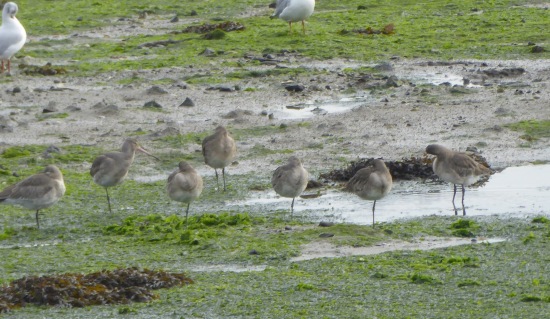
One of the latter was
colour-ringed G+WR - an old friend having been
a regular visitor to Emsworth Harbour since 2008. This
was my 130th sighting! G+WR was ringed at Farlington
Marshes by Pete Potts and his team on 10-Sep-08 as
adult male. Which means he must be at least 13 years
old.
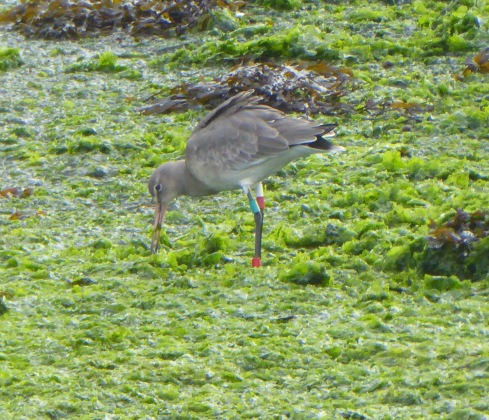
TUESDAY
DECEMBER 8 - 2020
Emsworth
Millpond
The male Pochard was on the town millpond
this morning with bright red eyes showing very nicely.
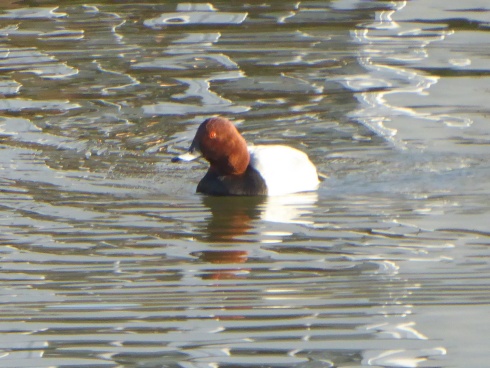
MONDAY
DECEMBER 7 - 2020
Emsworth
Millpond
Black-tailed Godwits, Dunlin and Brent Geese in the
harbour. Then was surprised to find a male
Pochard on the millpond - the first
there for years!
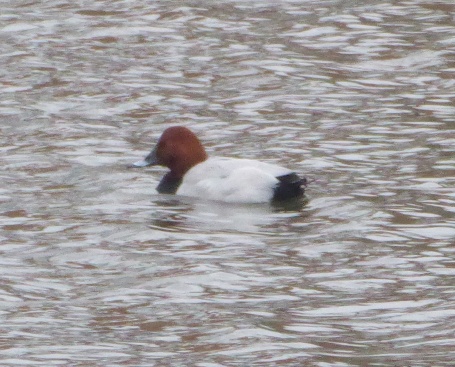
Bridge
Road wayside
Lee and his
mate from Norse were cutting the hedge and shrubs
around the car park. Sadly, he could not cut the grass
wayside as a truck was blocking the gap in the rails
which meant they could not get their machine through!
They will try again later.
WEDNESDAY
NOVEMBER 18 - 2020
Nore
Barn
I got to Nore Barn at 10am with tide rising to high
water in about 3 hours. The bay was well populated by
Brent Geese, Wigeon and Teal; the evocative calls of
the geese chattering echoed over the mudflats. A few
Black-tailed Godwits were feeding near the stream,
though many more were to arrive later as the tide
gradually pushed in.
The Spotted Redshank and its regular feeding companion
the colour-ringed Greenshank (G+GL) were feeding in
close proximity in the low water stream. Such good
friends!
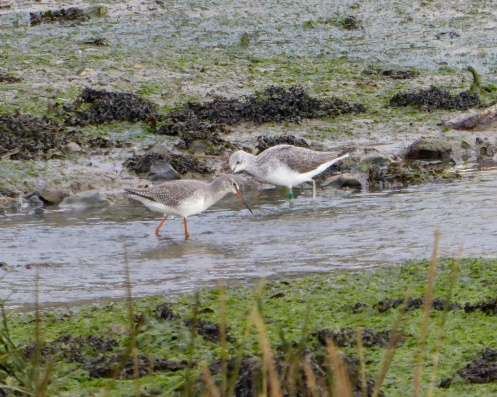
I took a few photos
and a short video of them feeding. . . .
https://youtu.be/NvTfEAs4XHU
A little later I was
joined by Colin and Tricia Brotherston who were hoping
to see the Spotted Redshank. Unfortunately, it was not
around while I was with them, though they did get
views of the Greenshank and a Common Redshank in the
stream. Maybe they saw the Spotted Redshank after I
left.
MONDAY
OCTOBER 19 - 2020
I got to Nore
Barn at 11am which - about 3 hours before high water.
The stream was empty and the tide still well out.
There were no birds in immediate harbour apart from a
pair of Mute Swans and a few Black-headed Gulls, so I
went for a walk through the woods, keeping an eye out
for the albino Squirrel that Susan Kelly saw
yesterday. I did not see it.
When I got back at about 11.30 the stream was filling
up and (hey presto) there were the Spotted Redshank
and the colour-ringed Greenshank (G+GL) together, just
like old friends, which is what they are!
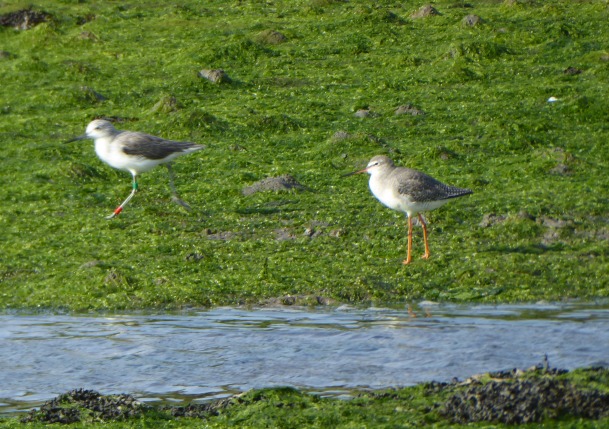
After a few minutes,
the Greenshank flew further downstream leaving me to
feast my eyes on the Spotted Redshank which remained
in the stream until I left about 30 mins later.

Video clip of Spotted
Redshank today . . . https://youtu.be/n0LmX3VDqMY
What a bird and
what a history! This is the 17th year running that I
have recorded this astonishing bird at Nore Barn since
2004.
This year Susan Kelly
was the first to see the Spotted Redshank at Nore Barn
on October 8th - which is the earliest first sighting
date since 2014 when it was seen on Oct 3. It is much
earlier than last year when our first sighting was Oct
31.
The bird is not ringed, but having watched it closely
for the past 16 years, I have no doubt it is the same
bird, from its timing and behaviour. For its history
and more details go to . . . Spotted
Redshank Home Page
SPECIAL UPDATE .... MONDAY OCTOBER 19 -
2020
Spotted
Redshank returns for 17th year!!
SATURDAY
APRIL 4 - 2020
Spotted
Redshank remains!
Susan Kelly is
sure the Spotted Redshank is still at Nore Barn. She
saw it close up this morning at 9am on a rising tide,
very close to the shore.
Susan says . . . "Quite
unmistakable, wading very deep, certainly not a Common
Redshank. I watched it feeding through field-glasses
for several minutes, both in and out the water. It
seemed oddly slowed-down, but may have been replete at
the end of the feeding session. When I returned after
walking through the wood the tide was much higher. I
could make out the shape of a wader snoozing on one
leg on the bank, but the vegetation and sun made it
impossible to see properly. There's a surprise. But
you'll be sceptical without a photo".
No I don't think I
need a photo as you are so sure. My only doubt is
whether it is 'our' Spotted Redshank as others could
be passing through. But as it was in the right place
and behaved the same way then I must agree. This is
the latest ever sighting, so I will need to change my
records!! Please keep watching.
That was our final
sighting of the season. For the complete history of
this remarkable bird please go to . . .
http://familyfellows.com/x-spotted-redshank.htm
TUESDAY
APRIL 1 - 2020
Adieu
Spotted Redshank
Our last
sighting of the famous Emsworth Spotted Redshank was
on 26 March by Susan Kelly who saw the bird in the
usual place in the stream at Nore Barn " . . . feeding
and bobbing all on his own, and looking very fat".
There has been no further sightings so I think we can
safely assume that it has now left our shores and is
on its way back to its breeding grounds, probably in
Northern Scandinavia. This is a few days later than in
recent years. Age-wise at 17+ the bird must be getting
near the end of its active life, so one has to wonder
if it will be back again next year to spend a 17th
successive winter at Nore Barn. At least it won't
succumb to the dreaded coronavirus.
For the complete history of this remarkable bird
please go to . . . http://familyfellows.com/x-spotted-redshank.htm
Chichester
Peregrines
The pair of
Peregrines are back nesting on Chichester Cathedral.
See the excellent David Shaw blog and a fascinating
live web cam of the nest. The birds have two eggs!!
Blog . . .
http://chichesterperegrinesblog.co.uk/
Web cam . . .
http://carnyxlive.co.uk/jwplayer/streams/chichester720ssl.html
TUESDAY
MARCH 31 - 2020
This morning's
observations:
Brook
Meadow
The
Rowans on the north meadow are in good shape
sprouting fresh spring leaves.
We stopped for a
distant chat with Maurice Lillie during which our
friendly Kestrel flew into one of the central
Willows.
Peter
Pond
The sucker
Elms near the Lumley path bridge have fresh
leaves. Sadly, these trees will not survive to
maturity.
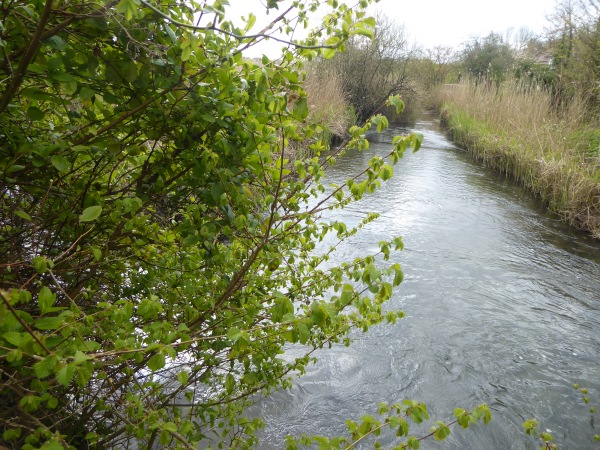
A Cetti's Warbler
was singing from the north of Peter Pond. The
first of the year.
Buds are almost ready
to burst on the Hawthorns on the south side of Peter
Pond. May blossom is coming and it is not yet April!
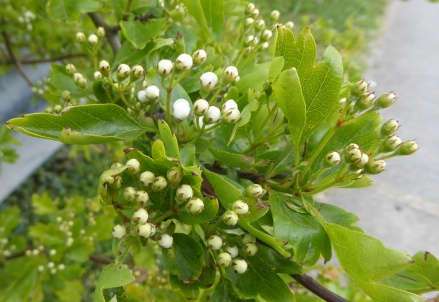
A Coot is on its nest
on the east side of Peter Pond.
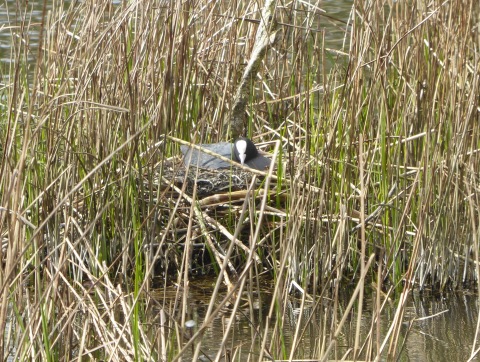
The Mute Swan pair was
on Peter Pond, one on the water and its mate tending
it its nest in the reedbeds.

MONDAY
MARCH 30 - 2020
Brook
Meadow
This morning's
observations:
The north bridge is now clear of fallen trees thanks
to the sterling work of Maurice and Nigel.

The large Ash on the
railway embankment which overhangs the north path is
now covered with clusters of dark red female flowers.
No sign of any leaves as yet on the Ashes, nor on the
Oaks.
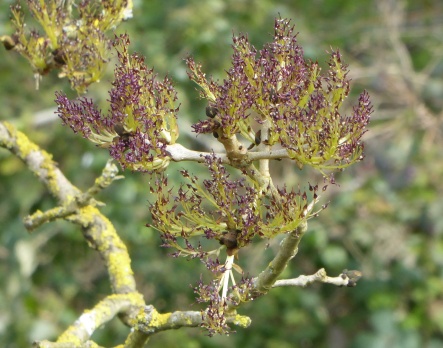
The brown spikes of
Greater Pond Sedge are now emerging on the Lumley
area. This is always the first of the sedges to show
itself.

The juvenile Kestrel
showing its distinctive diffusively streaked breast
was on its favoured Black Poplar perching tree
surrounded by yellow catkins.
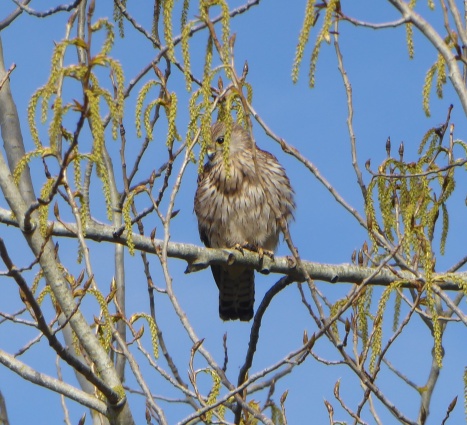
Here's a short video
clip of this new star of the meadow, allowing, as it
does, remarkably close human approach! We will have to
start calling it 'Kes'. . . . https://youtu.be/cFebPA9PoqA
The silver-greyish
leaves of Silverweed are now prominent on the Lumley
area.
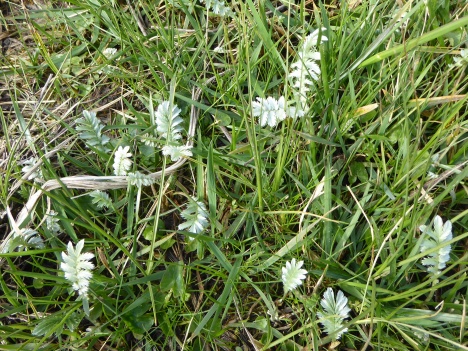
Primroses
Chris Oakley
sent me this photo of a cluster of Primroses that he
saw recently. They included some pink-flowered ones
which Chris thought might be a natural variety. I have
also seen pink-flowered Primroses on Brook Meadow - on
the new track created by the Environment Agency to the
Lumley Stream (see photo on this blog for Thursday
March 26). As these pink forms are usually seen near
habituation my guess is that they are the products of
hybridisation with garden Primulas, though probably
fairly well established in the wild.
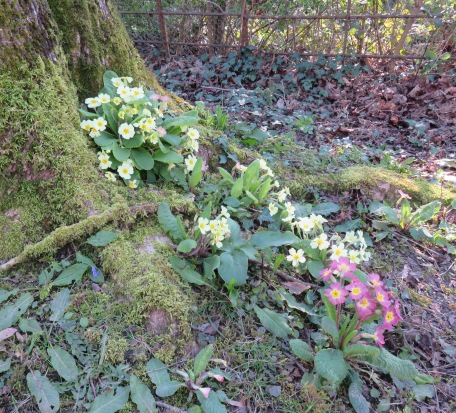
SUNDAY
MARCH 29 - 2020
Cuckooflowers
I spotted the
first Cuckooflower of the year on the Bridge Road
Wayside. This is the earliest first sighting since
2014. It will be interesting to see how many flowers
we get this year as the wayside has not been cut for
over a year and is running wild!
I counted a maximum of 338 on April 16. The record for
this wayside is 694 in 2012, though numbers have been
in decline since that high point. This is the best
photo I could manage. There will be others no doubt.
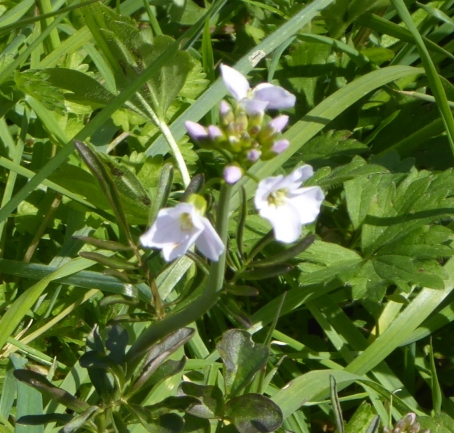
SATURDAY
MARCH 28 - 2020
Nore
Barn walk
This morning
Jean and I had our daily 'Boris exercise walk' to Nore
Barn and back. To avoid the cold northerly wind, we
went along Western Parade and returned via Warblington
Road. Very few walkers were about, so distancing was
no problem.
The tide was still fairly low by the time we got to
Nore Barn at about 11am. From the end of Warblington
Road I could see a small wader a long way out on the
edge of the channel which did not look like the
Spotted Redshank. I was right, for as it came closer,
I could clearly see the familiar outline and demeanour
of a Common Redshank.
This video clip shows the Common Redshank today . . .
. https://youtu.be/SLJaoFLAgXw
Moving over to the
stream, which was not much more than a trickle of
water, I found the regular colour-ringed Greenshank
(G+GL) feeding alone with no sign of the Spotted
Redshank! Has it gone?
Here is a video clip of the Greenshank . . .
https://youtu.be/lkk9aR6QVRM
Although it looks like
the Spotted Redshank has finally left on its migration
to its breeding grounds, we still need to keep a watch
- just in case it is still hanging around.
See the following link
for the history of the Nore Barn Spotted Redshank . .
. Spotted
Redshank at Nore Barn
Other
news
Yesterday, Jo
Bray saw a Swallow flying over Hampshire Farm
Meadows - the first I have heard of this spring.
FRIDAY
MARCH 27 - 2020
Lumley
walk
Jean and I had
our daily walk allowance around Lumley this morning.
We did not intend to go right round, but the weather
was so fine that we just carried on. No coffee stop,
but I had some Rolos in my bag which kept us going!
Not many people about, so keeping a good social
distance was no problem. Here are a few wildlife
observations.
Two Blackcaps
were singing along Lumley Road - one from Lumley copse
and the other from the garden of El Rancho. The very
early Blackcap singing on Brook Meadow two days ago
was probably just passing through. This one in Lumley
copse is in good breeding territory and is likely to
remain. We also heard several Chiffchaffs on the
walk.
The usual mass of
Greater Periwinkle (Vinca major) was in flower
just before the Mill House.
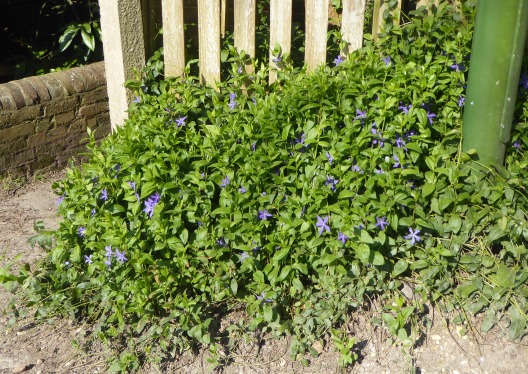
The regular
multi-coloured Wallflowers are out on the tall
garden wall north of Lumley Mill. I have discussed
these flowers with Ralph Hollins over many years and
his conclusion is that they are not the wild variety
but garden escapes. The only place I know of locally
for wild Wallflowers (Erysimum cheiri) which are
yellow is on the walls of Portchester Castle.
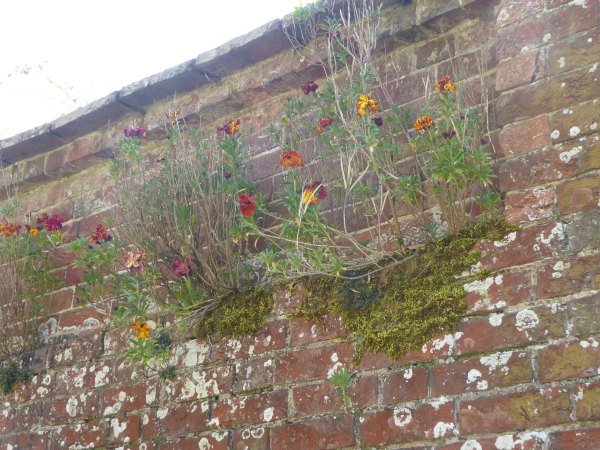
We were interested to
see several notices along Mill Lane asking for
dogs not to go into the Millstream which has protected
Water Voles. All gaps in the hedges were blocked.

It was good to see the
first Marsh-marigolds in flower in the
Millstream at Westbourne. Sadly, these attractive
flowers have not been seen for several years on the
river bank in Palmer's Road Copse.
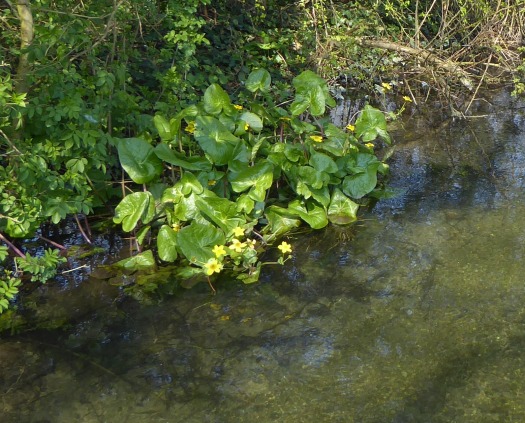
I had a look at the
flowers on one of the large Ash trees on the
Westbourne Open Space wayside at the top of Westbourne
Avenue and was pleased to discover they were clearly
male flowers emitting clouds of pollen. The photo on
the left taken on site shows a twig with clusters of
red coral-like unopened male catkins and a mass of
what appear to be spent catkins with pollen all gone.
The photo on the right is a cluster of male catkins
under the microscope x20.
Finally, I saw my
first Creeping Buttercup flower on the New
Brighton Road Junction wayside.
THURSDAY
MARCH 26 - 2020
Brook
Meadow
I had my daily
'Boris walk' on my own this morning which gave me more
opportunity to have a close look at some things. There
were very few people about, so there was no problem in
social distancing.
A Chiffchaff was singing in the north west
corner of the meadow, as yesterday, but no Blackcap.
That very early Blackcap yesterday was probably
passing through.
The large Ash tree on the railway embankment is
decorated with bunches of what seem to be flask-shaped
female flowers. I was concerned about this Ash last
year, but it now looks very much alive!
The Rowan trees on the Gwynne Johnson
plantation are now sprouting leaves shielding forming
flower buds.
Both yellow male and
green female catkins are now open on the Grey and Goat
Willows respectively. The yellow catkins were
attracting lots of insects in the warm sunshine. I
spotted Comma and Peacock butterflies plus Bee-fly and
Drone Fly. A yellow Brimstone fluttered past, but did
not stop for a photo! That's not a much of a photo of
the Bee-fly, but you can see its long proboscis
sticking into the flowers as it hovers.
The new track cut by
the Environment Agency down to the Lumley Stream has a
good selection of Primroses of various colours. While
I was there I said hello to Kath over her garden wall
in Rose Cottage - well distanced.
The large Weeping
Willow tree is a splendid sight at the top of the
south meadow - thanks are due to Brian Boak for this
fine addition to the meadow flora.
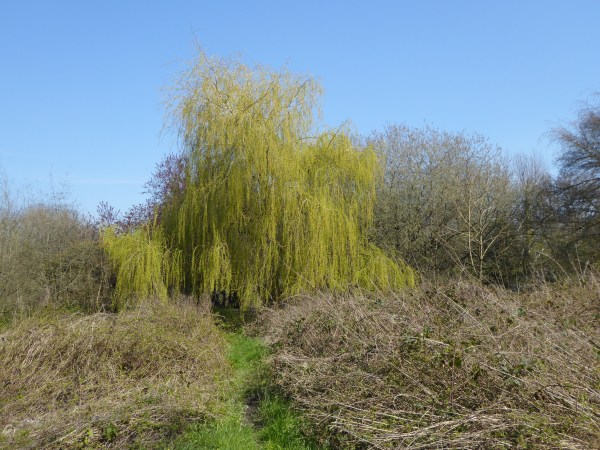
The Lumley Stream
continues to flow strongly with an attractive
babble.
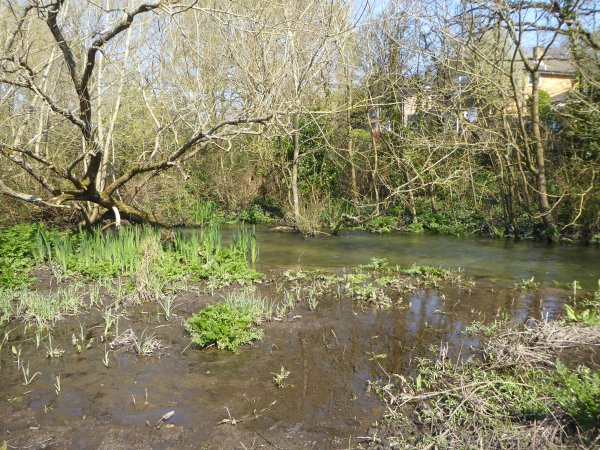
The cones of Field
Horsetail are now showing on the north meadow
orchid area and the Lumley area.
Moorhen is a common resident of the river.
Spotted
Redshank is still here
Susan Kelly
e-mails to say the Spotted Redshank is still at Nore
Barn as of 8.45 am Thurs. 26, feeding and bobbing all
on his own, and looking very fat. That's good as he
has a long journey to make. Susan has promised to look
out for our bird when she takes her regular walk to
Nore Barn for which I am very grateful, as I cannot
easily get there.
The bird has already stayed much longer than in any
year since 2013 and it will equal that record if it
shows up for Susan tomorrow!
See the following web page for all the last sightings
. . . Spotted
Redshank at Nore Barn
WEDNESDAY
MARCH 25 - 2020
Daily
walk
For today's 'Boris walk' Jean and I went through Brook
Meadow and round Slipper Millpond. At least two and
possibly three Chiffchaffs were singing on
Brook Meadow along with a Blackcap for the
first time this spring. This is the earliest Blackcap
on record. A Chaffinch was singing in Palmer's
Road Copse.
On Peter Pond the pen Mute Swan was on its nest
in the reeds with two eggs according to Dan
Mortimer. The second Mute Swan pair was in the Dolphin
Lake area, probably not nesting this year.
On Slipper Millpond, the Great Black-backed
Gulls were mating on the south raft.
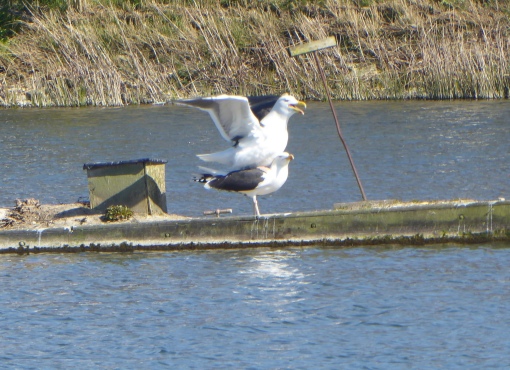
The pair Canada
Geese was circling the centre raft with intent of
nesting.
Spotted
Redshank is still here
Susan Kelly
reports the good news that the Spotted Redshank was at
Nore Barn at 9.15 this morning, feeding with an
Oystercatcher a little further up the channel at low
tide.
Mallards
in garden
Mallards are
fairly unusual garden visitors, but over the past 4
years we have been getting fairly regular spring time
visits from a male-female pair. They were here again
today helping to mop up the fallen seeds from the bird
feeders hanging from the tree. I suspect they are
looking for somewhere to nest, though we do tend see
them on a fairly regular basis until the end of May.
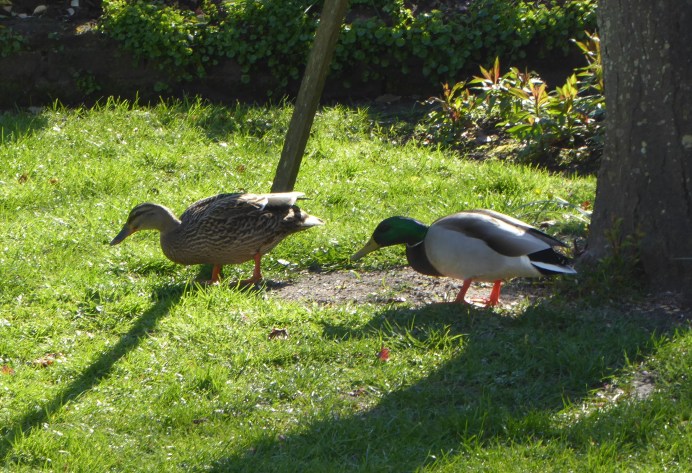
MONDAY
MARCH 23 - 2020
Brook
Meadow
It was such a
beautiful spring morning for an early walk - early for
me that is - 10am!. With the need for social
distancing in mind, I did the 5 minute walk from home
along a deserted street to Brook Meadow where other
people were there walking dogs, etc. Keeping to the
rules, we all steered well clear of one another,
giving cheery 'Good Morning' greeting as we passed. It
was just like wartime. It did my heart good to see a
couple of young lads with fishing nets on the river
bank. Here are a few pictures to remind one of the
beauty of the place. The south path is now dry but for
a few puddles at the southern end.
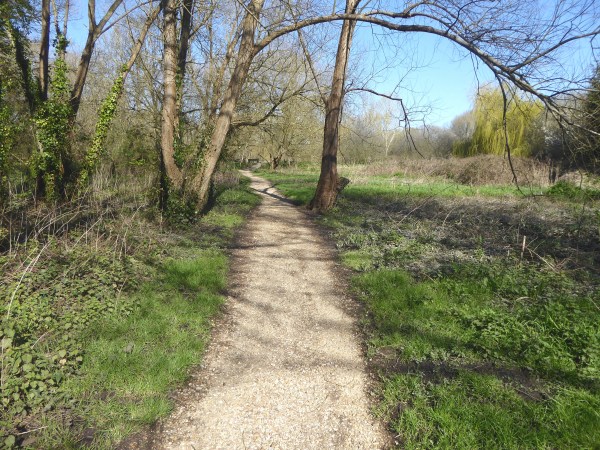
The main river path is
also good. The grassland is drying out, though remains
very boggy in parts.
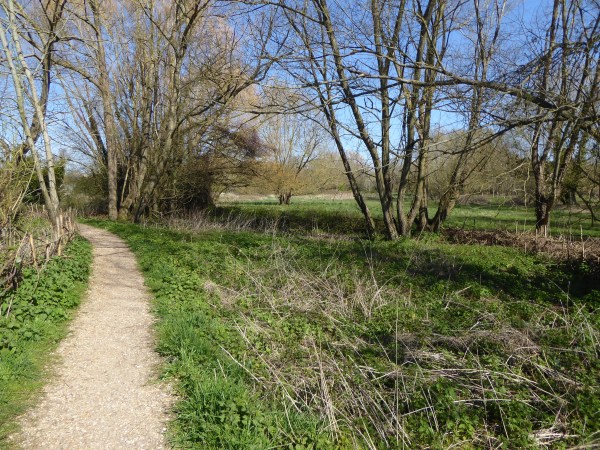
Looking across the
north meadow I could just detect a tinge of green of
on top of the tall Crack Willows.
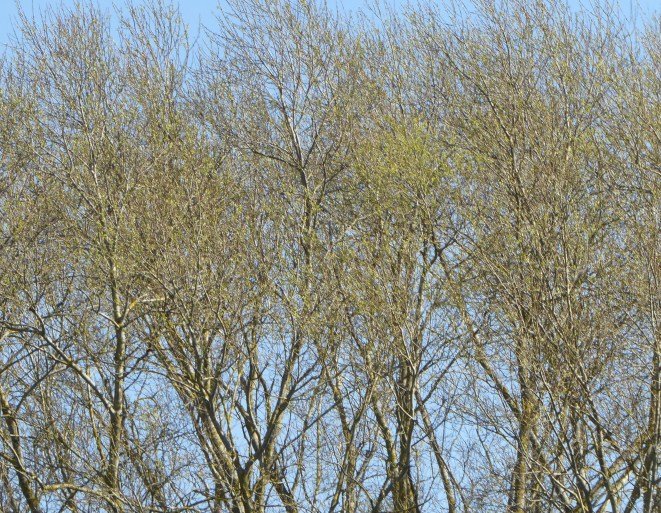
The sign in the
signcases was a stark reminder of good intentions

Butterbur
count
My main
objective this morning was to do a final count of the
Butterbur flower spikes. Today I took my time and
found most of the spurs, though many were quite tiny
and partly hidden amongst the burgeoning vegetation,
whereas others were large and getting old and worn.
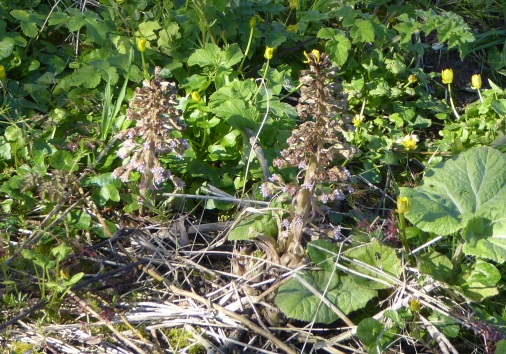
As I suspected, the
total count of 198 was way down on recent years which
have been consistently over 500; last year's count was
794 and the all time record was 1,150 in 2013. As
shown in the following chart, this year's total was
the lowest I have ever recorded over 20 years of
counting.
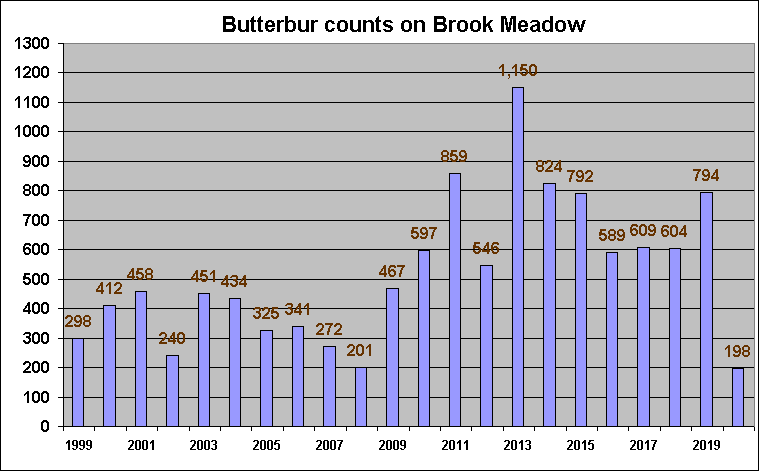
Butterbur grow in
several areas of the meadow, but the largest drop was
in the largest area immediately below the main seat
which fell to 147 from 704 last year. The smaller
Butterbur sites, on the river bank, south meadow and
east causeway were much the same as before.
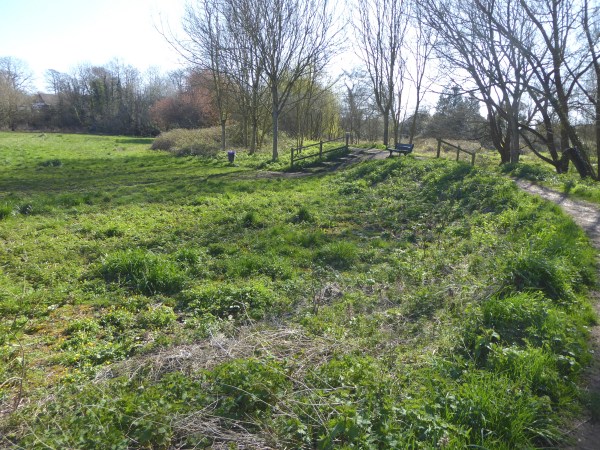
So what has happened?
There has been no special conservation work on the
main Butterbur area which could account for this
change. Weather is an obvious cause. This winter has
been warm and wet, but I can see no obvious reason why
this should disadvantage our native Butterbur
(Petasites hybridus) - which are all
male plants and which propagate and spread though
underground rhizomes. If anyone has any idea please
let me know.
Spotted
Redshank still here!
Susan Kelly
reports the continued presence of the Spotted
Redshank at 10am today feeding in the stream with
its favourite companion the colour-ringed Greenshank
(G+GR).
Yesterday on the Slipper Millpond Susan saw one of the
Swans aggressively attacking one of the Canada Geese
which are trying to nest on the centre raft. The swan
is clearly defending its territory, but Canada Geese
are determined birds. They managed to oust the Great
Black-backed Gulls from their traditional nesting site
on the centre raft four years ago and have been there
ever since. So don't write them off just yet.
Finally . . . a little piano piece from the delightful
Alma Deutcher to raise the spirits in these troubled
times . . . https://youtu.be/kR3T9OjoxSM
SUNDAY
MARCH 22 - 2020
Spotted
Redshank still here!
I had five
messages in my inbox this morning in response
yesterday's 'no Spotted Redshank' blog at Nore Barn,
all of whom reporting our marvellous bird was safe and
well. Three people saw it yesterday and another two
this morning.
Susan Kelly saw the Spotted Redshank at 8.30am
yesterday being bothered by dogs.
Steve Dennett saw the bird a bit later at 11am but it
was gone at approx 12.30
Then, Jo Bray, whom I met when I was there at 12.30
ish, saw the Spotted Redshank after they left us to
return to their car at the end of Warblington Road.
Joe sent a photo.
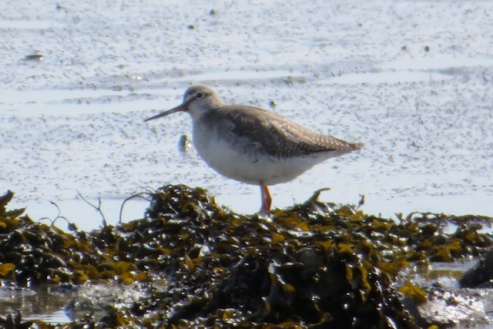
Mark Wagstaff was out
very early this morning (Sunday) doing his social
distancing at Nore Barn/Warblington and saw the
Spotted Redshank in the stream! On its own with no
Greenshank. Mark said ...
"I've
never known it to be so confiding. I got the sun
behind me and gave it quite a bit of distance and it
then walked towards me - almost to my feet! I kept
having to reduce the zoom on my camera rather than
always peering at something distant at the long end.."
Here is one of
Mark's photos - a cracker!!
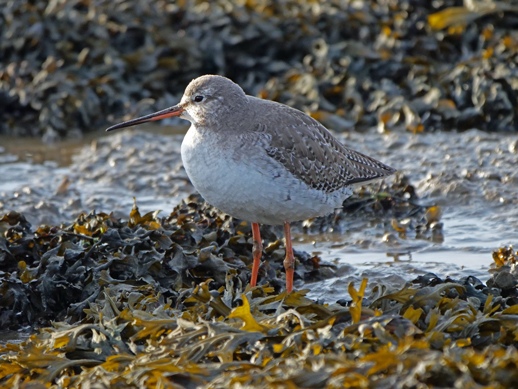
Tony Wootton was also
at Nore Barn his morning at 9.45 and found the Spotted
Redshank in the stream together with friend the
colour-ringed Greenshank (G+GL). What good news. Any
other sightings are always welcome.
Brook
Meadow
The leaning
Blackthorn on the Seagull Lane patch which
conservation volunteers righted during the past week
is leaning over again, presumably blown by the strong
winds. Maurice tells me that volunteers will have
another crack at righting it, but it is a heavy tree
and the roots have loosened. Not an easy task.
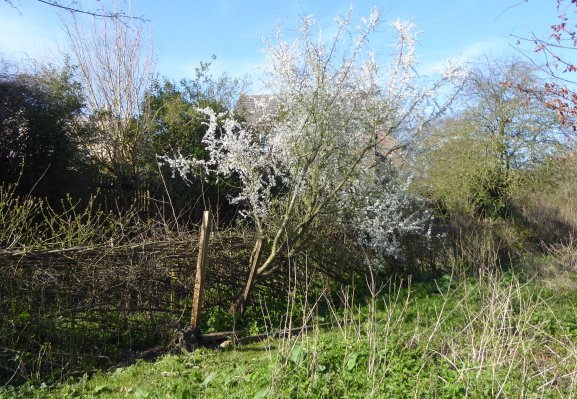
Maurice, Terry and
Nigel were working when I arrived this afternoon,
continuing the clearance of scrub from the west
bank of the river on the Seagull Lane patch. This
is a big job.
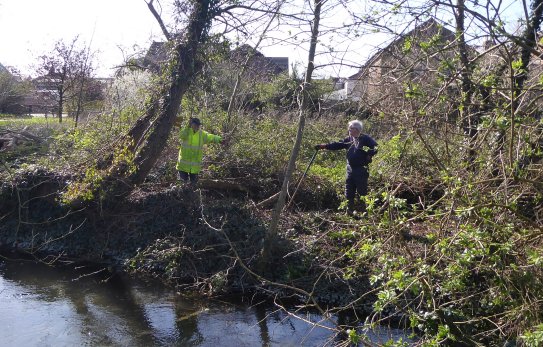
I tried to carry out a
Butterbur count, but it was hard work finding
the flower spikes in the burgeoning vegetation. My
impression that numbers are well down this year. I
shall try to do a final count in a few days.
The flooding on Brook Meadow has subsided and
the south meadow is open again. There are still a few
big puddles on the main path, but access is fine.
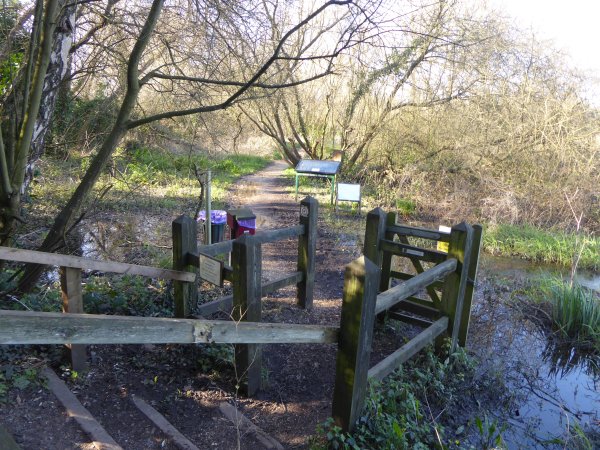
I walked back through
Palmer's Road Car Park where I found a bright Comma
butterfly basking in the warm sunshine on the edge
of the car park.

Dan Mortimer delivered
the three signcase display boards to my house. My job
is now to update the displays for Dan to replace them
in the cases later next week.
Hermitage
Millponds
The pair of
Mute Swans on Peter Pond are now nesting in the
reedbeds in the south west corner of the pond.
Although the nest can be easily seen from the
roadside, it is well within the beds and not easily
accessible. Dan Mortimer has seen two eggs already in
the nest.
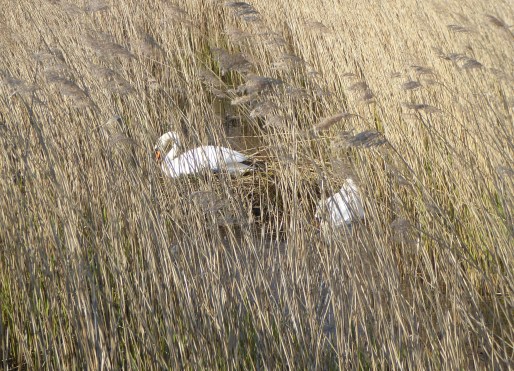
The pair of Mute Swans
on Slipper Millpond do not appear to be nesting. Maybe
they are a young pair? We shall see.
The pair of Canada
Geese were on the water near the centre raft where I
assume they will nest again.
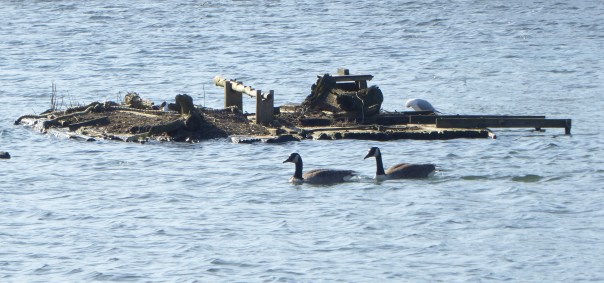
The pair of Great
Black-backed Gulls are settled on the south raft
where they are likely to nest as in previous years.
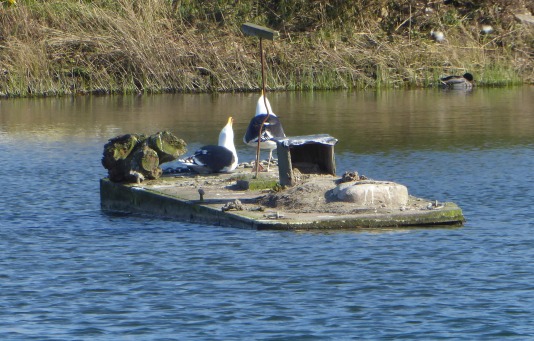
Here is a video clip
of the pair of gulls displaying and briefly mating . .
. https://youtu.be/tMviMFa14Us
Signs
of spring
Walking back
up Monks Hill in Westbourne earlier this morning, Jo
Bray saw four Curlews in the field where the cows
usually are. She's seen them there several times
recently. Jo also had Skylark singing on Hampshire
Farm Meadows, along with Chiffchaffs singing, and a
Kestrel flying across. She says, good to see and hear
these signs of spring in such an unsettling time. Yes,
the natural world goes on irrespective of human
problems.
SATURDAY
MARCH 21 - 2020
Nore
Barn - No Spotted Redshank
Jean and I
walked to Nore Barn for the second day running, mainly
to check on the Spotted Redshank. There was no sign of
the bird despite the tide being at the right state for
its presence. I am coming to the conclusion that the
bird may well have already left our shores for its
migration back to its breeding grounds in Northern
Scandinavia. My last sighting was on Monday 16 March,
but I shall keep checking for the next week or so and
would appreciate any further sightings. But I think
that is that for another year. Will it be back for a
17th year, who knows? But I shall be there
(coronavirus willing) to welcome it.
For the full history of this remarkable bird go to . .
. Spotted
Redshank at Nore Barn
Maureen Poweer was
also at Nore Barn today and did not see the Spotted
Redshank, but did get a snap of a Peacock butterfly
sunbathing. Wow, that is a beauty! I have not seen one
yet this year.
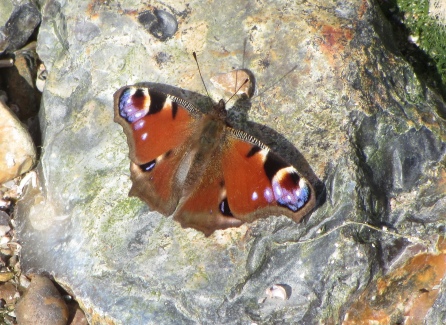
On the way to Nore
Barn we spotted a Great Crested Grebe and a female
Red-breasted Merganser swimming in close proximity
on the town millpond. This is the first time I can
recall having seen both these birds on the pond at the
same time. I wonder if they will get together (joke!).
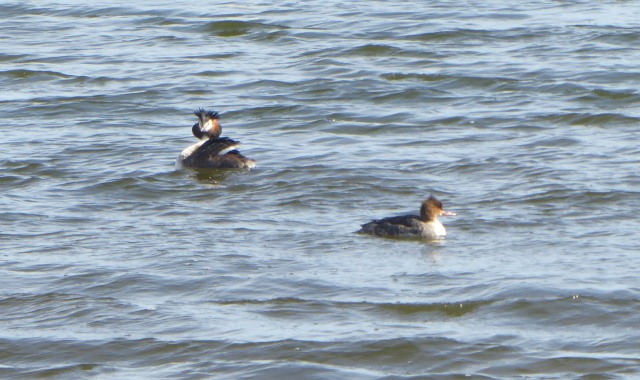
Walking round Nore
Barn Woods I noticed a Drone Fly (Eristalis
tenax) feeding on the blossom of Hawthorn. Named after
its resemblance to a Honey Bee drone, this insect can
be seen at almost any time in the year feeding on
nectar, but particularly prominent in early spring.

On the path to the
north of the woods we spotted a cluster of Violets
hiding away in the vegetation along the new fence. But
which Violet? Certainly, not Sweet Violet, which
leaves the choice of Common Dog-violet and Early
Dog-violet. From the small floppy petals and straight
dark violet unnotched spur my money is on Early
Dog-violet.
We walked home along
Warblington Road where we stopped to look at the
cheerful blue flowers of Greater Periwinkle
(Vinca major) - though there are other varieties. This
attractive plant was introduced into Britain for
cultivation from the Mediterranean by 1597 and first
recorded in the wild by 1650, so it's been here a
jolly long time! Cheer anyone up in these days of
gloom!
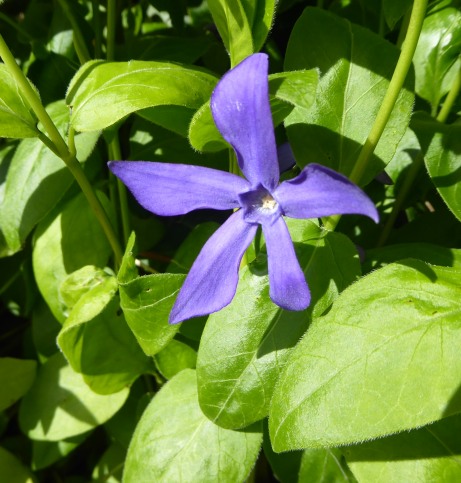
A couple of distractions from the gloomy
coronavirus news . . .
If you like opera have
a listen to this . . . https://youtu.be/ZBgmfTQtUvs
If you are an art
lover missing galleries you might be interested that
Paris Museums have put 100,000 images on line for
public use. See . . . https://kottke.org/20/01/paris-museums-put-100000-images-online-for-unrestricted-public-use
Warblington
Peter
Milinets-Raby reports on today's observations . . .
"Every March and April
for the last seven years, whilst I have been out
exploring the Emsworth and Warblington area, I have
always daydreamed about seeing one particular bird.
Well, this morning, that dream came true for
eventually I had my first sighting of a Red
Kite!! A nice adult bird was seen well this
morning, drifting very slowly into the east/northeast
wind as it headed inland over the Warblington Church
tower. The undisrupted bird of the day!"
"I was out around the
fields and shore of Warblington this morning for a
couple of hours from 8:15am (Along with a surprisingly
huge number of people - I've never seen so many people
walking around the area in inappropriate shoes, in a
rainbow of ridiculously bright coloured coats getting
caked in mud - all half-heartedly trying to practice
Social Distancing!).
On arrival the Egrets
were also not practicing Social Distancing as they
were all huddled up against the hedge out of the
wickedly, chilly wind (See photos). There were 20
Little Egrets and 4 Cattle Egrets (3 adults in summer
dress and a first winter moulting - see photos).

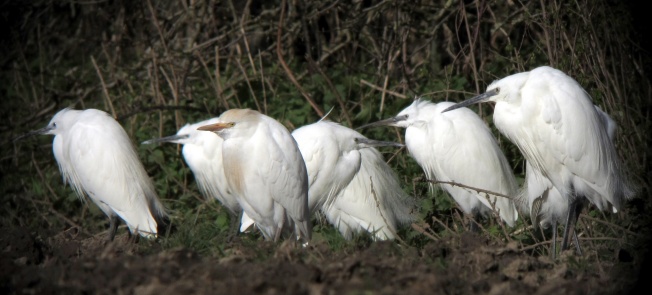

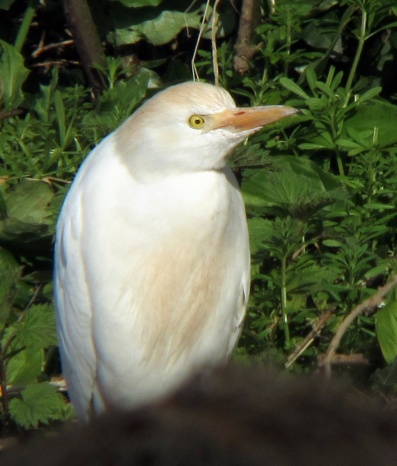
Once they were warmed
up, they fanned out and fed amongst the cattle. I
managed to get one photo of the first winter bird
catching what I assume to be a ugly looking
Leatherjacket!.
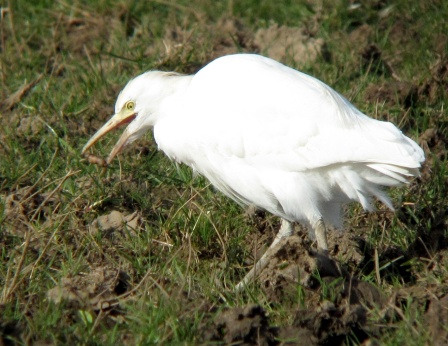
Over the Castle Farm
area were 2 Mistle Thrush, 1 Buzzard, 1 Sparrowhawk
and 1 Kestrel.
In the Ibis Field was a singing Chiffchaff. On the
straw dump were 3 Water Pipits (See photo of two),
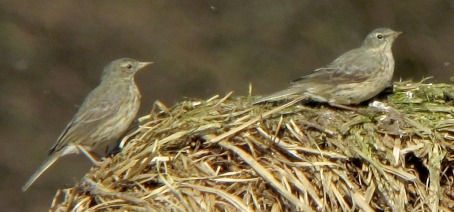
1 Meadow Pipit and 1
Pied Wagtail - though 9 pipits flew off!!

In and around this
field were 4 Skylarks and 6 Linnets.
High tide at Conigar Point produced only 1 Great
Crested Grebe and 3 Red Breasted Merganser
Off Pook Lane were another Great Crested Grebe and
another 3 Red Breasted Merganser, 25 Brent Geese and 2
Shelduck.
FRIDAY
MARCH 20 - 2020
Nore
Barn walk
Jean and I
walked to Nore Barn along Warblington Road and back
along Western Parade for our daily constitutional this
morning in a chilly NE wind, but preferable to the
blustery south westerlies that we have been getting
recently.
The tide was fairly low by the time we got to Nore
Barn, so I was not surprised that the Spotted Redshank
was nowhere to be seen. It had most likely been and
gone. I usually record negative sightings at this time
of the year in order to establish the latest sighting
date - in the last two years these were 22 Mar and 23
Mar. So we are very close to its regular leaving date
when it will be off once again on its long journey
back to its breeding grounds, probably in Northern
Scandinavia. Fare forward friend and journey well. If
anyone has any further sightings please let me have
them. Thanks.
For the full history of this remarkable bird go to . .
. Spotted
Redshank at Nore Barn
Apart from the
occasional calls of Oystercatcher and Curlew and a few
gulls the harbour was deserted as most of our winter
visitors have now left. However, to our great
pleasure, we came across a lingering Brent Geese
family comprising two adults and four youngsters
feeding close to the shore. We will soon bid these
birds farewell too though their journey to their
arctic breeding grounds is far longer than that of the
Spotted Redshank. The four juveniles show up well in
the photo with one of the parents on the left.
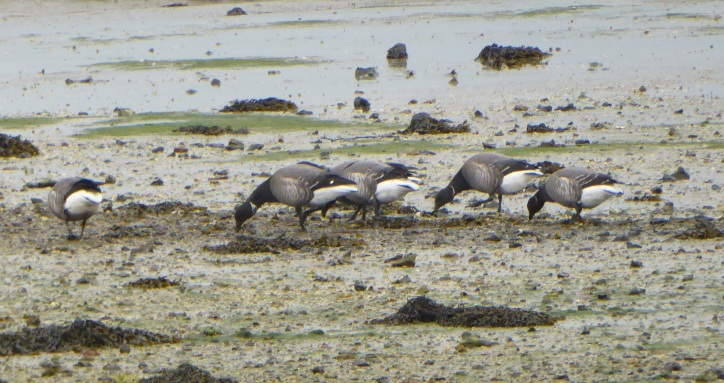
We were blessed with
an abundance of young Brent Geese in local harbours
this winter indicating a very good breeding season.
This should boost their population following some poor
breeding seasons.
On the flower front,
we stopped to admire the abundance of Sweet Violets on
the grass verges of Warblington Road. Other flowers to
catch our eyes included Three-cornered Garlic growing
against the garden fences and Green Alkanet on Western
Parade. Nearer the sailing club I looked at the Hoary
Cress (aka the Portsmouth weed) but no sign of flowers
as yet - probably out in 2 weeks.
Garden
Sparrowhawk
Peter
Milinets-Raby reports the appearance of a juvenile
Sparrowhawk in his garden
He says . . . "All
I ever seem to get in my Havant garden of late are
visiting Sparrowhawks. Find attached today's visitor
on the roof of the Summer House. Since, I last posted
a photo of a Sparrowhawk (sometime last month), I
think I have had seen 2 Wood Pigeons in the garden
along with a single Blackbird!!! Dreadful! Flying over
the garden in the last few days, has been a different
prospect altogether, with Mediterranean Gull, Buzzard,
Cormorant. Meadow Pipit and Grey Heron."
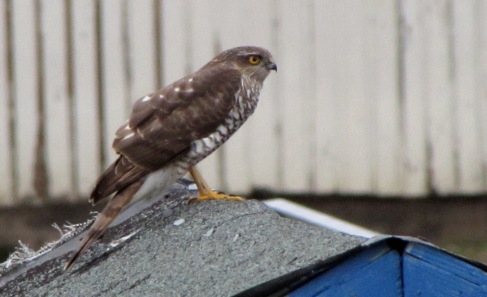
THURSDAY
MARCH 19 - 2020
Brook
Meadow workday
It was a dank
and drizzly morning, but there was a good turn out of
10 volunteers for the special 'coronavirus work
session' organised by Colin Brotherston. Colin had
previously outlined the conservation group's position
regarding volunteering on Brook Meadow during the
coronavirus crisis which were circulated to all
volunteers. Everyone appreciated this information but
were keen to get on with physical work on the meadow
as a release from the doom and gloom in the news. The
volunteers spaced themselves about 2 metres apart for
the group photo - three more arrived after the photo
had been taken.
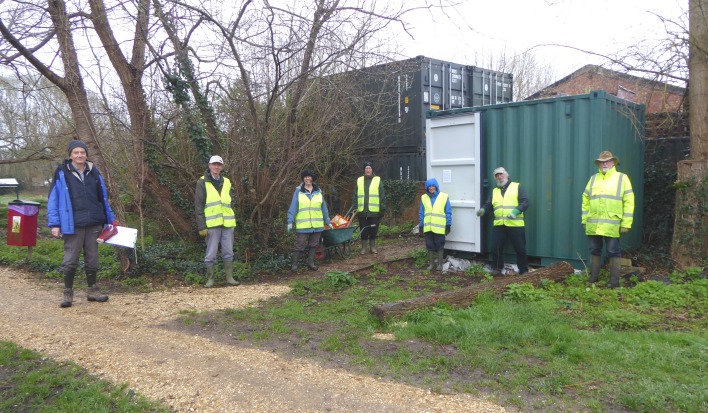
Colin outlined the
main tasks which involved moving chippings and gravel
to the paths and transplanting grass to the river bank
on the Seagull Lane patch.
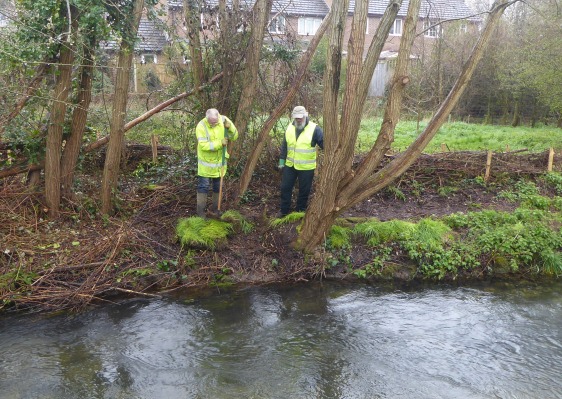
For the full workday
report and more photos go to . . . https://www.brookmeadow.org.uk/conservation-news/
Other
news
Dan Mortimer
told me the good news that the pair of Mute
Swans on Peter Pond were now nesting in the
reedbeds in the south west corner of the pond where
they have nested in previous years and ... they have a
single egg!
Dan helped me to mark out the area below the seat for
the Butterbur count which I shall be carrying
out later this week.
Dan also confirmed that he would collect the
signcase display boards from the meadow and
deliver them to my house at his convenience. The
spring displays up date is now overdue!
Maurice Lillie was stung by a Bumblebee while
working on the river bank. Bumblebees are normally
very docile creatures unless aroused. I suspect
Maurice may have disturbed this insects nest in the
ground and got stung for his trouble! Queen Bumblebees
are actively building nest sites at this time of the
year.
I had a look at the planted Oak saplings in the
Seagull Lane patch. The buds look healthy, but there's
no sign of leaves.

While out for a walk
round Thornham Point Lesley Harris told me she had
seen what she was sure were two White Admiral
butterflies. I must admit I found this difficult
to believe, since White Admirals are a typically
summer butterfly of woodlands, such as Hollybank
Woods. They overwinter as a caterpillar but I have
never heard of any emerging this early. I checked the
Hants and Sussex Butterfly Conservation sites but
there was nothing there apart from the regular spring
butterflies, ie, Brimstone, Comma, Peacock, Small
Tortoiseshell, etc.
Spotted
Redshank
It was good to
hear from John Evans who has just moved into Emsworth.
On Monday 16 March John photographed the Spotted
Redshank. Here is one of his images, very good too.
Thanks John.

On the basis of
previous years I expect the Spotted Redshank to leave
our shores in the next week or so, hopefully to return
again next year. The history of this remarkable bird
which has just spent its 16th consecutive winter with
us in Emsworth can be seen on the special web page
dedicated to it. Go to . . . Spotted
Redshank at Nore Barn
WEDNESDAY
MARCH 18 - 2020
Long
Copse Lane
For our daily
constitutional walk, Jean and I had a very nice stroll
along Long Copse Lane; we parked at the top of
Hollybank Lane and walked from there. It is an easy
walk along a tamac road with few vehicles and fewer
people. We considered going into Hollybank Woods, but
the paths looked rather muddy.
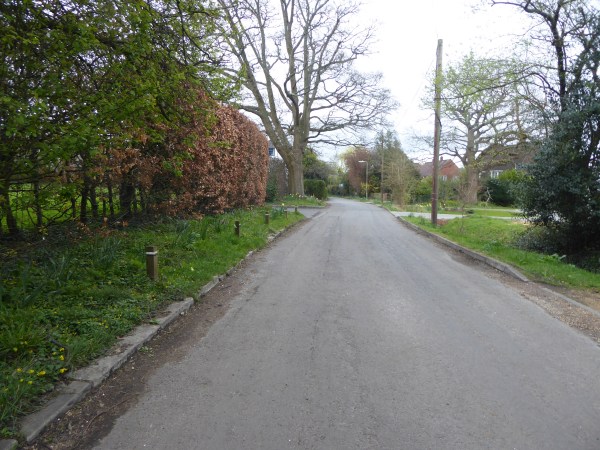
We really enjoyed
seeing several spring flowers coming into bloom along
the roadside, including White Comfrey, Cow Parsley,
Wood Anemone, Three-cornered Garlic, Green Alkanet and
Cherry Laurel. The latter was particularly abundant at
the start.

On the way we stopped
to admire the magnificent Oak trees in the fields to
the north of the lane and also to listen to a Mistle
Thrush singing strongly from that direction.
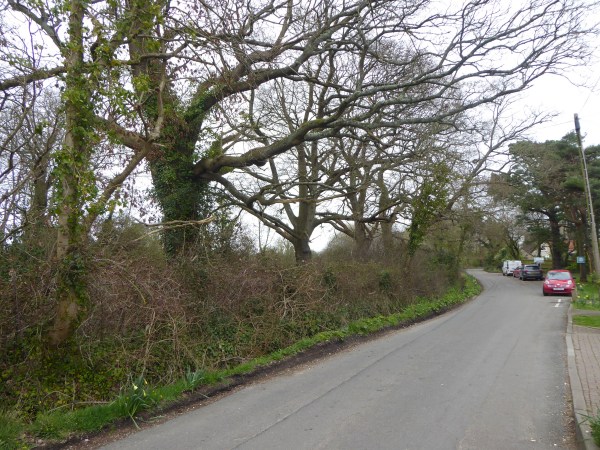
Notes
on some of the flowers on Long Copse Lane:
Cow
Parsley - There were a few plants of Cow Parsley
just coming into bloom, our first of the year with
many more to come. In a few weeks much of this road
and other roads in the area will be lined with this
most wonderful and prolific flower of spring. I always
look forward to walking through the avenue of aromatic
flowers that lines the main river path through Brook
Meadow. It is sometimes called Queen Anne's Lace,
probably after its attractive lace-like flowers, but I
like the humble name best.
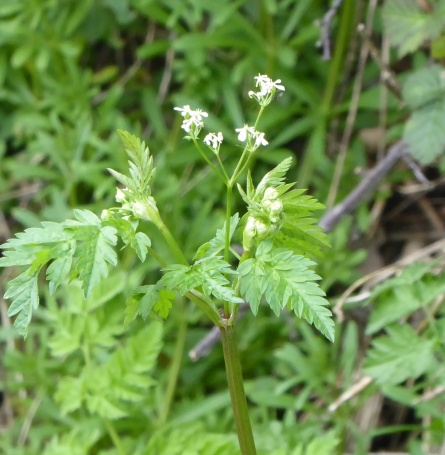
Three-cornered Garlic (Allium triquetrum) -
This is a garden escape and was growing in some
abundance on the roadside verge. It is easily mistaken
for Wild Garlic or Ransoms which usually flowers a bit
later. It has bell-like flowers which are very similar
to those of Summer Snowflake which is also currently
in flower; but the former has a narrow green stripe
down each petal whereas the latter has green tipped
petals. Three-cornered Garlic gets its name from its
triangular angled stems. Introduced into Britain in
1752 it rapidly escaped into hedgebanks and
churchyards and is now widespread mainly in the South
and East of England. Not much loved by gardeners I
gather!
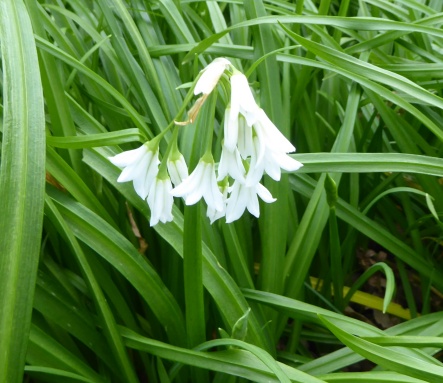
White
Comfrey (Symphytum orientale) - This is our only
Comfrey with pure white flowers. Common Comfrey
sometimes has whitish flowers but they are tinged with
yellow or purple. White Comfrey is also the first of
the Comfreys to flower in early spring. Unlike Common
Comfrey which is native to this country, White Comfrey
was introduced from West Russia and Turkey, but is now
naturalised in hedgerows, churchyards and waste
places, chiefly in Eastern and Southern England.
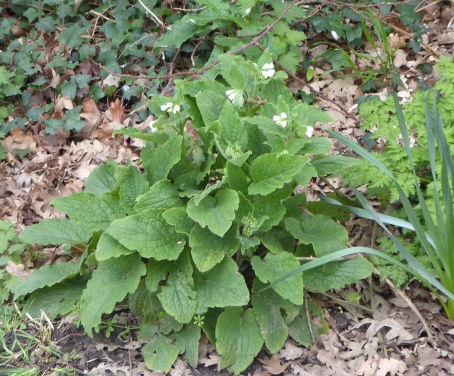
Green Alkanet -
This is a garden escape which seems to establish
itself well in the wild, though usually not far from
habitation. Describing the plant as 'Green' is
somewhat puzzling to me as the flowers are distinctly
bright blue with a white 'eye' which gets it its
alternative name of 'Bird's Eye'. There is also a good
crop along the garden walls along the shore road at
Western Parade in Emsworth.
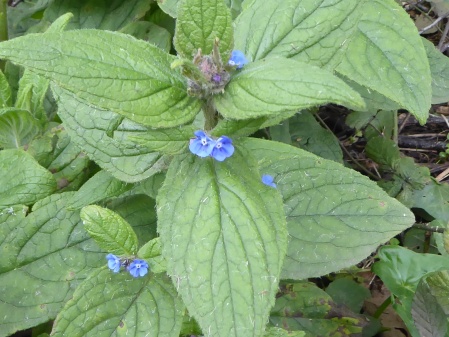
Ravens
in Chichester
Chris Oakley
has seen a pair of Ravens at the east end of
Chichester Cathedral and thinks they may be nesting
somewhere up there. Well, Chris, you are correct! The
Chichester Peregrine blog confirms that a pair of
Ravens are building a nest on the Cathedral, not far
away from the Peregrines. The blog includes the
following photo taken on 22/02/2020.
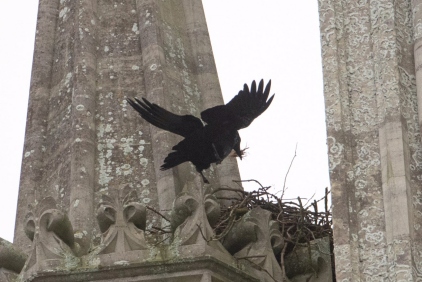
For the latest news of
the Ravens and the Peregrines see . . https://chichesterperegrinesblog.co.uk/
TUESDAY
MARCH 17 - 2020
Brook
Meadow
I had a walk
through Brook Meadow this morning and down to the
Hermitage Millponds, keeping well clear of other
people! Lots of dog walkers on the meadow. I was the
only one without one! Here are a few of my
observations.
Meadow Foxtail
- The first spikelets of the year are now out on the
north meadow (though not yet in full flower with
anthers).
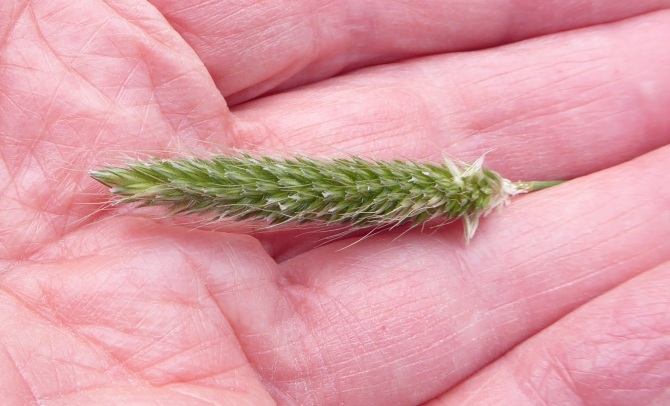
Meadow Foxtail is
always the first of the grasses to flower on Brook
Meadow in the spring, but Mar 17th is exceptionally
early even for Meadow Foxtail. Looking back through my
records I find this is the earliest ever date for the
appearance of Meadow Foxtail spikelets since I started
recorded in Year 2000.
Butterbur - Many of the Butterbur flower spikes
on the area below the main seat are now well
developed, but many are still in bud stage.

So I will delay the
annual count of the flower spikes for a few more days,
though I can't leave it too long as the surrounding
vegetation is also growing fast and threatens to
envelop the flower spikes making them difficult to
count. Last year I did the count on Mar 22.
Black Poplar - The two large Black Poplar trees
on the edge of the Lumley copse are now covered in
thin yellow-green catkins which I think are female;
apparently male catkins would be fatter and red.
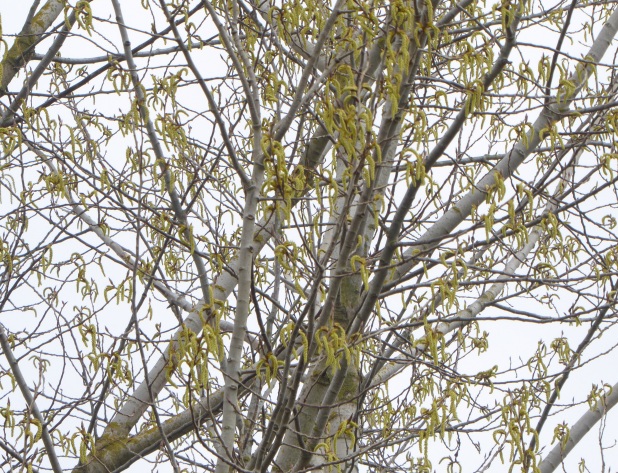
These two Poplars were
planted on the meadow in November 2004 in memory of
Frances Jannaway's mother are probably hybrids, but I
am not sure which hybrid. The Collins Tree Guide has a
section devoted to Black Poplar hybrids, some of which
are female clones and others male clones. Of the
female clones I am tempted to go for 'Florence Biondi'
(p,158) on the basis of its description as straight
stemmed, graceful with fairly sparse foliage denser at
the crown, but I could be wrong!
Queen Bumblebee - I watched for a few minutes a
large black Queen Bumblebee with a bright red tail
exploring the rough grassland on the on the edge of
Lumley copse, presumably looking for a suitable site
for a nest to lay eggs. I took a few photos and
managed a video clip. https://youtu.be/4Hf2YhxtcIQ
Identification -
possibly Bombus lapidarius which Bryan Pinchen says is
one of the most common species, being widespread
across most of the country. Queens emerge in March and
April and nests produce workers from May to August.
The worker is a similar colouration to the Queen but
much smaller.
Lumley Stream - Continues to flow swiftly. A
video clip taken from the edge of the Lumley area.
https://youtu.be/FOmc6sYVAEo
Hermitage
Millponds
Fresh green
reeds are growing on the edge of one of the new
channels cut by David Gattrell on the west side of
Peter Pond.
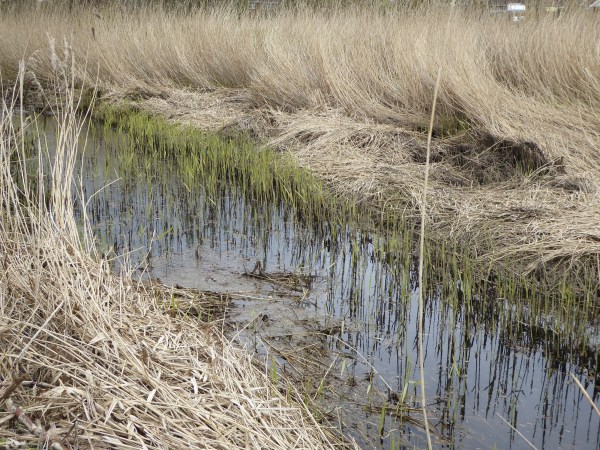
The pair of Mute Swans
was on Peter Pond with no clear sign of any nest
building as yet, though it can't be all that far
ahead.
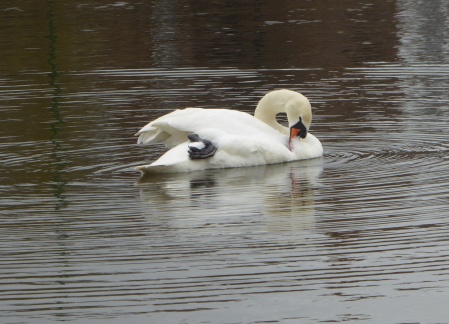
Meanwhile over on
Slipper Millpond the pair of Canada Geese have
returned to the centre raft where they have nested
successfully for the past 3 years. The pair of Great
Black-backed Gulls will presumably nest on the south
raft as before, though they were not present at the
time I was there this morning.
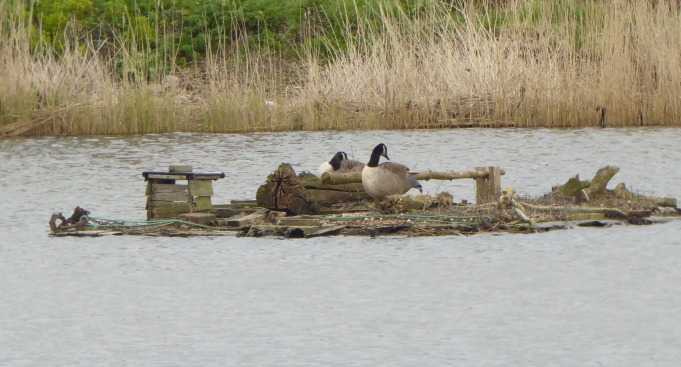
The second Mute Swan
pair was on the pond close to Chequers Quay when I was
there.
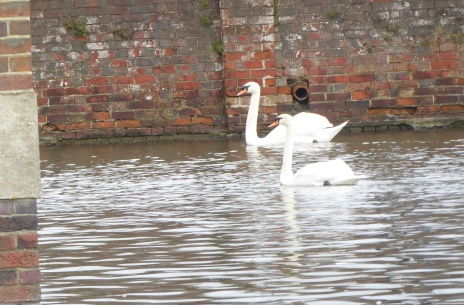
Slipper Millpond
always provides an attractive bathing stop for flocks
of gulls. They are mostly Black-headed Gulls, but also
include several Mediterranean Gulls - here are three
of them in close proximity. Their distinctive mewing
type calls can be heard at some distance. These gulls
will be returning soon to the breeding colonies in
Langstone Harbour.
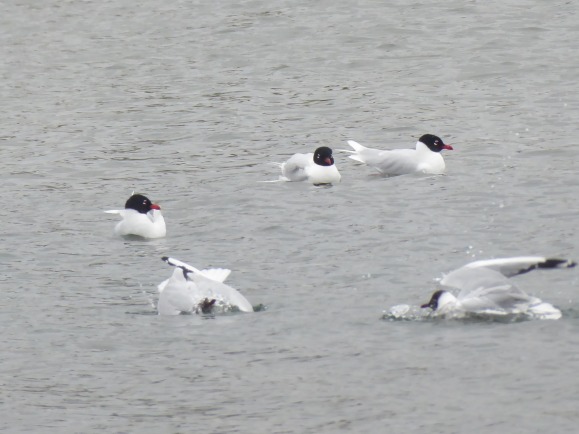
Here is a video clip
of a group of 3 Med Gulls having a good wash in
company with a few Black-headed Gulls.
https://youtu.be/VYpozZe7pNs
Langstone
Mill Pond
Peter
Milinets-Raby spent 90 minutes down Langstone Mill
Pond this morning checking on the Grey Herons. The
only changes to his previous visit were:
Nest One: Adults were observed swapping over brooding
duties and on each occasion tiny chicks were faintly
heard calling.
Nest 14: Young growing older.
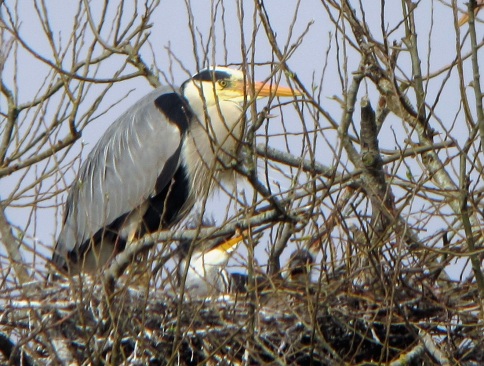
And, a new pair were
displaying and mating in the small gap between Nests
14 and 10 and bringing sticks to a tiny pile of a nest
(See photos).
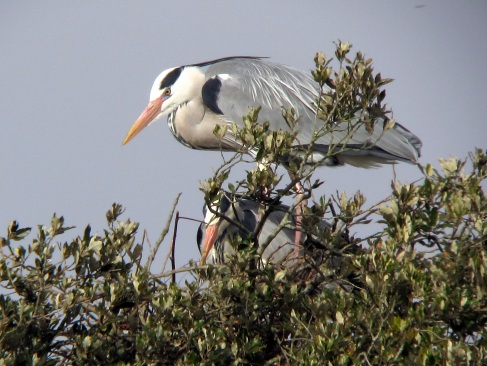
This is a new location
and is given the number 18. Now, is this the pair who
half built a nest at location 16 on 2nd March and gave
up on it?

Other birds around the
pond included two pairs of Tufted Duck, 5 Teal, 4+ Med
Gulls over and 3 Little Egrets in full spring plumes
on the main Holm oak standing over old nests!
In the paddock were 8 Teal and a singing
Chiffchaff.
Off shore there were 9 Dunlin, 1 Greenshank, 4 Grey
Plover and a Bar-tailed Godwit. Also of note were 41
Shelduck, 13 Brent Geese, a Great Crested Grebe and 5
Red Breasted Mergansers
Peregrines
The Chichester
Peregrines are back on the Cathedral all ready for
another breeding season. The webcam for ongoing
coverage will soon be in action. For all news go to .
. . https://chichesterperegrinesblog.co.uk/
Meanwhile, Keith
Betton reports the first Peregrine egg in the nest at
Winchester Cathedral ... a day later than last
year!
See . . . https://www.winchester-cathedral.org.uk/the-peregrines-return-in-2020/
MONDAY
MARCH 16 - 2020
Great
Crested Grebe
Jean and I had
a walk round the town millpond on this very
spring-like morning. We stopped to chat to Susan Kelly
when we all watched a Great Crested Grebe with a fine
crest diving and eventually flying off with its
distinctive scuttling walking-on-water action. This
may well have been one of the grebes seen displaying
on Thorney Island by Christopher Evans last Friday.
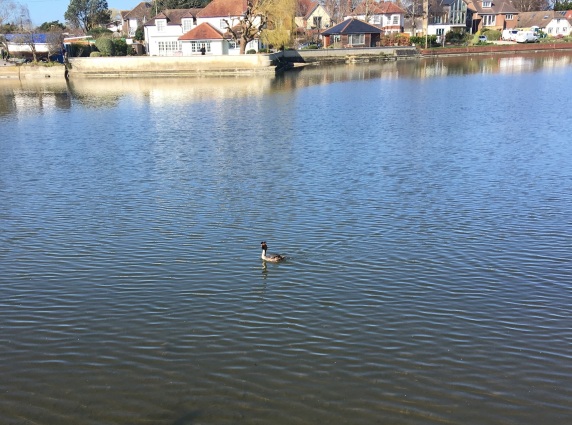
Brook
Meadow
A little later
I walked over to Brook Meadow to look for signs of
spring in wildlife. On entering the Seagull Lane gate
I encountered Maurice and Terry from the conservation
group working to straighten the Blackthorn tree on the
west side of the Seagull Lane patch that had been
partly blown over in the wind.
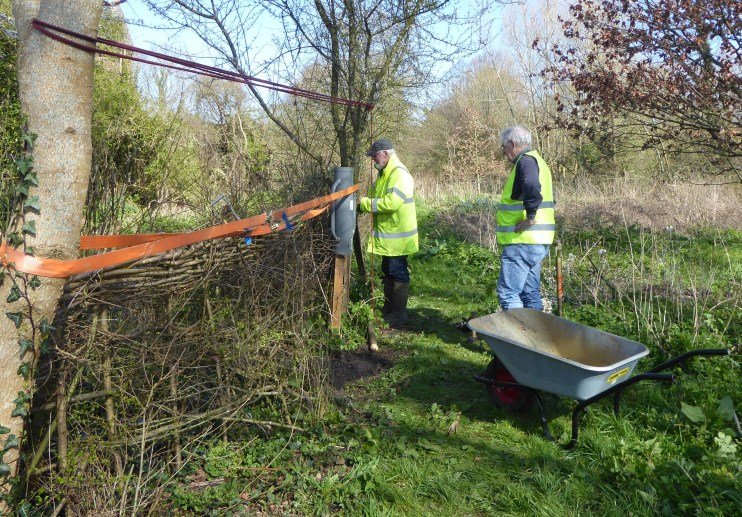
As Maurice said . . .
"My
old climbing rope that lives in HQ was useful but even
with our combined strength, (Terry's 90% and my 10%)
we needed greater pulling power. Our friend Steve in
Artec Engineering came to the rescue with two
adjustable webbing ratchet ties and after a lot of
head scratching we pulled the tree at last to an
acceptable position."
Well done, chaps.
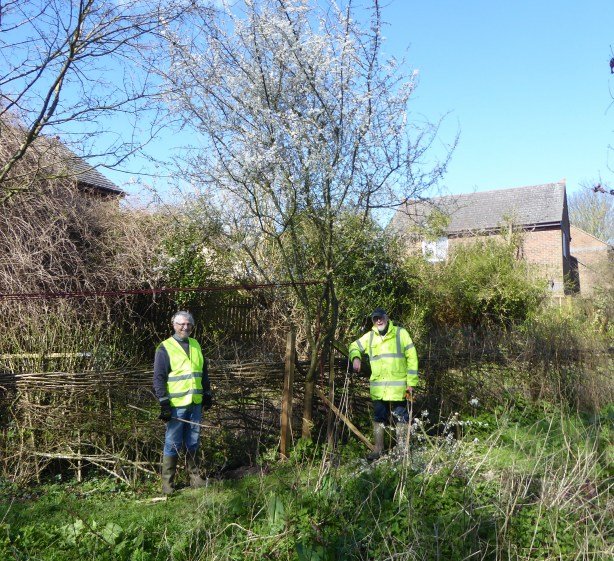
The two workers were
being closely watched by a Robin first from the handle
of a fork pushed into the ground and secondly from the
dark ash remains of a bonfire.
I had another look at
the Ash flowers on the north path which I am
fairly sure have a mixture of male and female parts as
shown in the following photos. Here is the whole
flower cluster with the female styles and stigmas
sticking up above the coral-like male anthers which
split open to release pollen. In fact, pollen can be
seen sticking to various parts of the flowers.
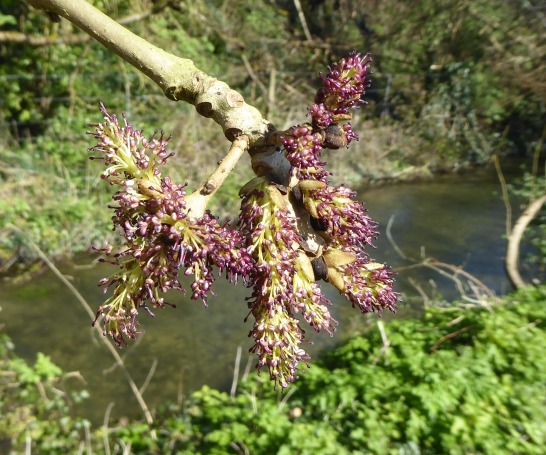
Here are two photos
taken through the microscope with the male flowers on
the left and the female flowers on the right.
I was delighted to see
two butterflies heralding the onset of spring, a
male Brimstone and a Small
Tortoiseshell, neither of which stayed still for a
photo.
Spotted
Redshank
I popped over
to Nore Barn at about 14.30 with the tide rising to
high water in about 2 hours. Unusually, the Spotted
Redshank was feeding not in the stream as is his wont,
but along the shore at the end of Warblington Road.

Occasionally, he waded
out further out in a search for food
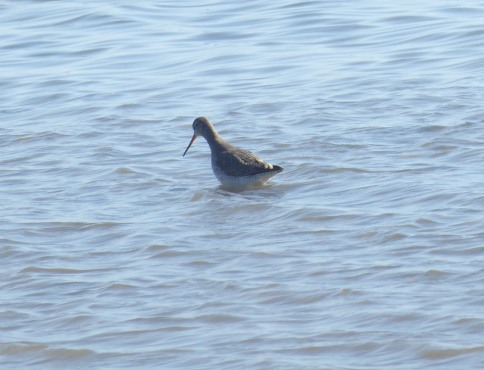
Maureen Power also
reported seeing the Spotted Redshank feeding in the
stream later this afternoon - about 4pm.
Warblington
Peter
Milinets-Raby was out this morning in the glorious
sunshine for a couple of hours from 9am. I visited the
fields and shore at Warblington. The highlights were
as follows:
The Cemetery held 2 Coal Tit and the Ibis Field had 4
Long-tailed Tits and a Song Thrush.
At the straw dump I had 5 Water Pipits (one nice pink
breasted bird and one in partial moult), 2 Rock
Pipits, 1 Meadow Pipit and 2 Pied Wagtails.
In the fields around were 5 Skylarks (2 singing) and a
flock of 61 Linnets.
In the distance from the direction of Nore Barn Wood I
could hear a Chiffchaff and a Great Spotted Woodpecker
singing and drumming. Over the wood for a good ten
minutes was a displaying Sparrowhawk with
butterfly-like flight.
It was a very low tide and consequently Conigar Point
had very little to offer with just 17 Shelduck and 13
Brent Geese.
The SSSI field held the best bird of the day and that
was a singing Meadow Pipit complete with display
flight. What a great sound. I have not heard this at
all since I started watching the area some 7 years
ago. Shame about the ignorant dog owner in the SSSI
field letting his two poodle types run riot and flush
a female Mallard and the Pipit.
High in the sky over the SSSI field were 5 soaring
Buzzards and 2 Raven.
On the low tide mud off Pook Lane were 4 Grey Plover,
98 Brent Geese, 22 Shelduck, 2 Wigeon, 2 Bar-tailed
Godwits, 2 Med Gulls, 1 summer plumaged Great Crested
Grebe, 12 Red breasted Mergansers, 7 Dunlin and 38
Teal. With the help of Mark I eventually found the 3
Cattle Egret with 4 Little Egrets feeding in the
fields by the main road. In the hedge here was a
singing male Blackcap. Nice views.
Two Cattle Egrets
- photo by Mark Wagstaff

For the previous month
go to . . . March
1-13